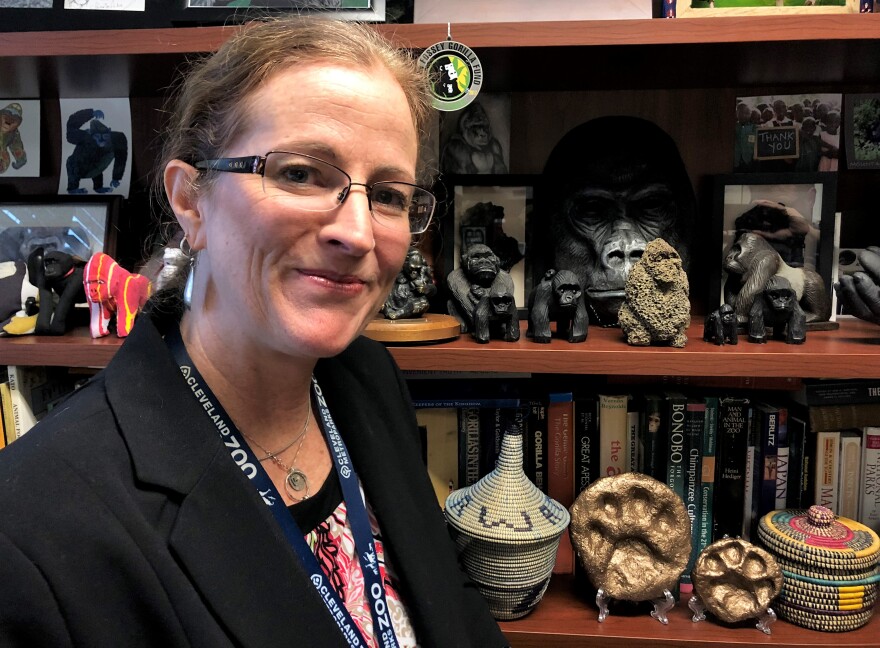They’re the largest of the great apes.
Imposing and impressive, gorillas inspire fear and admiration.
But local researchers say they also serve as models of gentleness and family harmony.
In this week’s Exploradio, we look at Ohio’s role in gorilla conservation and visit the gorillas in our midst.
Kristen Lukas, director of conservation and research at the Cleveland Metroparks Zoo, acknowledges that she has,“an irrational lack of fear of gorillas.” Instead, she oozes affection for the massive animals.
We’re watching Cleveland’s four gorillas amble into their glass enclosure at the primate house, including the daunting male Mokolo.
"He’s got such a sweet face,” coos Lukas, as the 32 year-old silverback takes a long look at her through the glass.

His calm presence conveys power.
“He is so impressive," says Lukas. "He’s got this really tall sagittal crest, which is the part of his head that protrudes out and gives the silverback their signature look."
Lukas adds that female gorillas prefer males that have taller sagittal crests, "and believe it or not, that have really muscular butts.” She laughs.
Building a gorilla family
Mokolo had been a bachelor for 23 years, until the other male he'd been living with in Cleveland died in 2017.
It was then decided that Mokolo should have some female companionship, a big change for the middle-aged silverback.
A mature female, Fredrika was brought in from the Miami zoo, “and when Mokolo met her for the first time, needless to says, he was stunned," says Lukas.
But, she adds, "Fredrika did a great job of coaching him on remaining calm as he was awkwardly worked through his new role," a role as leader of a troop of now three females, Fredrika, Kebi Moyo and Nneka.
Lukas heads the American Zoo Association Species Survival Plan for gorillas, the group that monitors the welfare of the 350 western lowland gorillas in U.S. zoos, decides where they’ll live and when to breed them.
Her research in Cleveland has helped zoos better manage bachelor males, improve gorilla diets and teach gorilla moms to be better mothers.
It’s the kind of expertise that began more than 60 years ago with the arrival of the world’s first captive born gorilla in, of all places, Columbus, Ohio.
Birth of a Survival Plan
Audra Meinelt is a curator at the Columbus Zoo. She spent nearly 20 years caring for Colo, who not only was the first gorilla born in a zoo, but when she died in 2017 at the age of 60, was the oldest gorilla known.
“I think it provided hope,” says Meinelt: hope that the species could be brought back from the brink of extinction.

Colo, says Meinelt, was a creature full of grace and composure. “She was the queen of the zoo and she acted as such,” she says.
Meinelt was captivated by Colo, and by Colo's descendants, who are part of the zoo's three gorilla groups.
"There’s a lot of wonderful peaceful aspects to gorilla society,”says Meinelt. “They provide an ideal that a lot of us wish we could be more like."
Dian Fossey's Legacy
Gorillas had once defined the terror of the jungle in popular culture, until researcher Dian Fossey revealed their gentle nature.
“A degree of tolerance and harmony is seen as the family members gather to enjoy each other’s company. It is a tranquil time, and grooming has begun,” she narrates in a documentary made shortly before her tragic death at the hand of poachers in 1985.
Fossey spent many hours ‘talking’ with gorillas in the wild, mimicking their vocalizations.
Gorilla communication also speaks volumes to the Cleveland Zoo’s Kristen Lukas’s in her studies of family dynamics.

“They have a laugh vocalization that sounds like ours in reverse. We laugh, ‘ha ha ha’, and a gorilla laughs, ‘ah ah ah’ - so you hear a huge huge silverback gorilla, ‘ah ah ah’ tickling and playing with a little infant,” says Lukas.
Lukas is board secretary of the Dian Fossey Gorilla Fund International, which continues Fossey’s research with mountain gorillas in Rwanda and the Congo, and her efforts to save the species.
Lukas also directs the American Zoo Association’s SAFE gorilla conservation program.
She says gorillas in zoos are ambassadors of their species, meeting us face to face, and when “you look straight into their dark brown eyes, you see there’s a lot going on there."
"And maybe you realize they’re not nameless things," says Lukas, "you start to understand these are individuals that have personalities, that are important members of their social units and their families,”
Gorillas, she says, remind us that saving their native mountains and forests helps us save ourselves.
The remaining gorillas in the wild are under assault from deforestation, war, poaching, and decimation from the West African Ebola outbreak.
Zoos, through the work begun here in Ohio, may someday be their final refuge.












